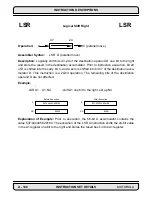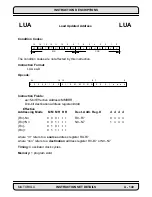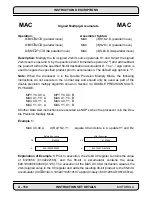
INSTRUCTION DESCRIPTIONS
A - 160
INSTRUCTION SET DETAILS
MOTOROLA
Parallel Move Descriptions: Thirty of the sixty-two instructions allow an optional paral-
lel data bus movement over the X and/or Y data bus. This allows a data ALU operation to
be executed in parallel with up to two data bus moves during the instruction cycle. Ten
types of parallel moves are permitted, including register to register moves, register to
memory moves, and memory to register moves. However, not all addressing modes are
allowed for each type of memory reference. Addressing mode restrictions which apply to
specific types of moves are noted in the individual move operation descriptions. The fol-
lowing section contains detailed descriptions about each type of parallel move operation.
When a 56-bit accumulator (A or B) is specified as a source operand S, the accumulator
value is optionally shifted according to the scaling mode bits S0 and S1 in the system
status register (SR). If the data out of the shifter indicates that the accumulator extension
register is in use and the data is to be moved into a 24- or 48-bit destination, the value
stored in the destination D is limited to a maximum positive or negative saturation con-
stant to minimize truncation error. Limiting does not occur if an individual 24-bit accumu-
lator register (A1, A0, B1, or B0) is specified as a source operand instead of the full 56-bit
accumulator (A or B). This limiting feature allows block floating-point operations to be
performed with error detection since the L bit in the condition code register is latched.
Note: Whenever an instruction uses an accumulator as both a destination operand for a
data ALU operation and as a source for a parallel move operation, the parallel move
operation occurs first and will use the data that exists in the accumulator before the
execution of the data ALU operation has occurred.
MOVE
Move Data
MOVE
Summary of Contents for DSP56K
Page 12: ...xii LIST of TABLES MOTOROLA List of Tables Continued Table Page Number Title Number ...
Page 13: ...MOTOROLA DSP56K FAMILY INTRODUCTION 1 1 SECTION 1 DSP56K FAMILY INTRODUCTION ...
Page 31: ...MOTOROLA DATA ARITHMETIC LOGIC UNIT 3 1 SECTION 3 DATA ARITHMETIC LOGIC UNIT ...
Page 50: ...DATA ALU SUMMARY 3 20 DATA ARITHMETIC LOGIC UNIT MOTOROLA ...
Page 51: ...MOTOROLA ADDRESS GENERATION UNIT 4 1 SECTION 4 ADDRESS GENERATION UNIT ...
Page 77: ...MOTOROLA PROGRAM CONTROL UNIT 5 1 SECTION 5 PROGRAM CONTROL UNIT ...
Page 124: ...INSTRUCTION GROUPS 6 30 INSTRUCTION SET INTRODUCTION MOTOROLA ...
Page 125: ...MOTOROLA PROCESSING STATES 7 1 SECTION 7 PROCESSING STATES STOP WAIT EXCEPTION NORMAL RESET ...
Page 167: ...STOP PROCESSING STATE MOTOROLA PROCESSING STATES 7 43 ...
Page 168: ...STOP PROCESSING STATE 7 44 PROCESSING STATES MOTOROLA ...
Page 169: ...MOTOROLA PORT A 8 1 SECTION 8 PORT A ...
Page 176: ...PORT A INTERFACE 8 8 PORT A MOTOROLA ...
Page 177: ...MOTOROLA PLL CLOCK OSCILLATOR 9 1 SECTION 9 PLL CLOCK OSCILLATOR x x d Φ VCO ...
Page 191: ...10 2 ON CHIP EMULATION OnCE MOTOROLA SECTION 10 ON CHIP EMULATION OnCE ...
Page 218: ...USING THE OnCE MOTOROLA ON CHIP EMULATION OnCE 10 29 ...
Page 604: ...INSTRUCTION ENCODING A 338 INSTRUCTION SET DETAILS MOTOROLA ...
Page 605: ...MOTOROLA BENCHMARK PROGRAMS B 1 APPENDIX B BENCHMARK PROGRAMS T T T T T P1 P3 P2 P4 T T T ...
Page 609: ...BENCHMARK PROGRAMS MOTOROLA BENCHMARK PROGRAMS B 5 ...
Page 611: ...BENCHMARK PROGRAMS MOTOROLA BENCHMARK PROGRAMS B 7 ...
Page 613: ...BENCHMARK PROGRAMS MOTOROLA BENCHMARK PROGRAMS B 9 ...
Page 615: ...BENCHMARK PROGRAMS MOTOROLA BENCHMARK PROGRAMS B 11 ...
















































